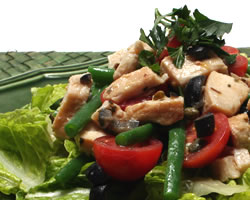People eating at fast food restaurants often underestimate the calories in their meals by 12 to 41 percent, according to studies by Brian Wansink, professor of consumer behavior at Cornell University. Large portions seem to be one of the main culprits in this inaccuracy and may cause more problems as large portions start to seem normal.
The bad news from one of Wansink's latest studies is the more you eat, the more likely you are to underestimate your meal's calories. Researchers asked 105 customers at fast food restaurants to estimate the calorie content of the meals they had ordered, and then checked the actual total from restaurant nutrition information.
Overall, people under-estimated the calories in their meals by 23 percent. But those who ordered relatively small meals that provided about 470 to 560 calories only slightly under-estimated their meals. The larger the calorie load of the meal, the more people misjudged it. People whose meals totaled 1,100 to 1,260 calories under-estimated their meals' calories by 38 percent, guessing they totaled only 570 to 759 calories.
Another study asked 40 college students to estimate the calories in 15 fast food meals that differed only in portion. The meals�which consisted of various combinations of three different size portions of chicken nuggets, fries and cola�contained a total of 445 to 1,780 calories. Students accurately estimated the calories in smaller meals. However, in the meals with large portions they underestimated calories by more than 22 percent.
Some experts suggest that our frequent exposure to large portions may be blunting our ability to recognize how large our portions are. In one study, peoples' estimates of food portions were often wrong by more than 20 percent. Those who were more confident in their estimates were not any more accurate than those less certain. In another study, people were asked to bring in a "medium" bagel, muffin, potato, apple or cookie. Items brought in varied by 200 to 600 percent within the same food type. Almost all exceeded the definition of medium in standard nutrition recommendations.
Some people suggest that if fast food restaurants made information about nutrition content more obvious, customers would be able to better control their calorie consumption. However, in a study Wansink dubbed "The McSubway Project" more available nutrition information did not seem to help. Researchers compared 250 customers of Subway (where nutrition information was widely available on napkins, wrappers and signs) with 250 customers at McDonald's (where nutrition information was inconsistently available on small-print posters).
Although McDonald's customers chose higher calorie meals that averaged about 710 calories, they more accurately estimated what they were getting, underestimating by only about 12 percent. In contrast, Subway customers' meals averaged about 560 calories, but they underestimated content by about 41 percent, believing their meals contained only about 335 calories.
Wansink suggests the "McSubway" discrepancy was due to what he calls the "halo effect." When people are convinced food is healthy, they often assume that everything is low-calorie, and forget to account for calories from added cheese, mayonnaise, chips, drinks and other extras. To keep a closer tab on what you're eating, Wansink advises to estimate the calories of individual items separately rather than the meal as a whole, and to remember that a large meal probably has about twice the calories you think it does.
0
AICR








